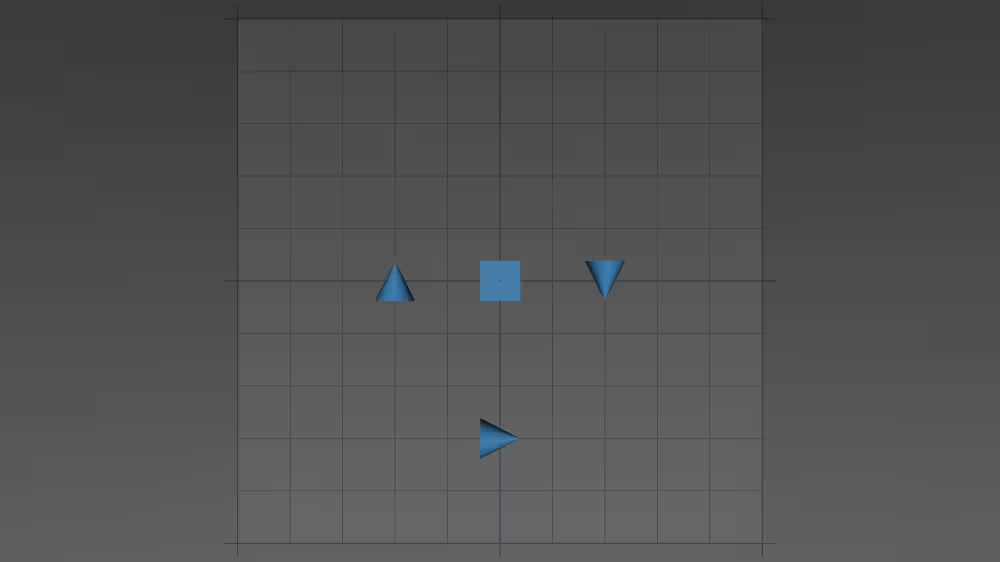PlaneSensor
Overview
PlaneSensor converts pointing device motion into 2D translation parallel to the local Z=0 plane.
The PlaneSensor node belongs to the PointingDeviceSensor component and requires at least support level 1, its default container field is children. It is available since VRML 2.0 and from X3D version 3.0 or higher.
Hierarchy
1
2
3
4
5
6
+ X3DNode
+ X3DChildNode
+ X3DSensorNode
+ X3DPointingDeviceSensorNode
+ X3DDragSensorNode
+ PlaneSensor
Fields
| Type | Access Type | Name | Default Value |
|---|---|---|---|
| SFNode | [in, out] | metadata | NULL |
| SFString | [in, out] | description | ”” |
| SFBool | [in, out] | enabled | TRUE |
| SFRotation | [in, out] | axisRotation | 0 0 1 0 |
| SFBool | [in, out] | autoOffset | TRUE |
| SFVec3f | [in, out] | offset | 0 0 0 |
| SFVec2f | [in, out] | minPosition | 0 0 |
| SFVec2f | [in, out] | maxPosition | -1 -1 |
| SFVec3f | [out] | trackPoint_changed | |
| SFVec3f | [out] | translation_changed | |
| SFBool | [out] | isOver | |
| SFBool | [out] | isActive |
SFNode [in, out] metadata NULL [X3DMetadataObject]
Information about this node can be contained in a MetadataBoolean, MetadataDouble, MetadataFloat, MetadataInteger, MetadataString or MetadataSet node.
Hint
SFString [in, out] description “”
Author-provided prose that describes intended purpose of this node.
Hints
- Include space characters since a description is not a DEF identifier. Write short phrases that make descriptions clear and readable.
- Many XML tools substitute XML character references for special characters automatically if needed within an attribute value (such as & for & ampersand character, or " for “ quotation-mark character).
SFBool [in, out] enabled TRUE
Enables/disables node operation.
SFRotation [in, out] axisRotation 0 0 1 0 [-1,1] or (-∞,∞)
axisRotation determines local sensor coordinate system by rotating the local coordinate system.
SFBool [in, out] autoOffset TRUE
Determines whether previous offset values are remembered/accumulated.
SFVec3f [in, out] offset 0 0 0 (-∞,∞)
Sends event and remembers last value sensed.
Warning
- ROUTE connecting translation_changed to set_offset creates a self-reinforcing positive feedback loop and results in unmanageable response.
SFVec2f [in, out] minPosition 0 0 (-∞,∞)
minPosition and maxPosition clamp translations to a range of values measured from origin of Z=0 plane default maxPosition < minPosition means no clamping.
Hint
- Create a LineSensor by constraining one axis (minPosition.x=maxPosition.x) or (minPosition.y=maxPosition.y).
SFVec2f [in, out] maxPosition -1 -1 (-∞,∞)
MinPosition and maxPosition clamp translations to a range of values measured from origin of Z=0 plane default maxPosition < minPosition means no clamping.
Hint
- Create a LineSensor by constraining one axis (minPosition.x=maxPosition.x) or (minPosition.y=maxPosition.y).
SFVec3f [out] trackPoint_changed
trackPoint_changed events give intersection point of bearing with sensor’s virtual geometry.
Warnings
- It is an error to define this transient outputOnly field in an X3D file, instead only use it a source for ROUTE events.
- trackPoint_changed events represent unclamped intersection points on plane surface. Browsers can interpret drags off of the surface in various ways. Note that translation_changed events are clamped by minPosition/maxPosition and thus may be preferable.
SFVec3f [out] translation_changed
translation_changed events equal sum of relative translation change plus offset value.
Warning
- It is an error to define this transient outputOnly field in an X3D file, instead only use it a source for ROUTE events.
SFBool [out] isOver
Hover over geometry by aiming the mouse (or pointing device) to generate isOver events. Sensor sends output event isOver=true event when pointing device moves over sensor’s geometry, and later sends output event isOver=false event when pointing device moves off.
Warning
- It is an error to define this transient outputOnly field in an X3D file, instead only use it a source for ROUTE events.
SFBool [out] isActive
Select geometry by activating the pointing device (for example, clicking the mouse) to generate isActive events. Output event isActive=true is sent when geometry is selected (for example, when primary mouse button is pressed), output event isActive=false is sent when geometry is deselected (for example, when primary mouse button is released).
Warning
- It is an error to define this transient outputOnly field in an X3D file, instead only use it a source for ROUTE events.
Advice
Hints
- Create a LineSensor by constraining one axis: (minPosition.x=maxPosition.x) or (minPosition.y=maxPosition.y).
- This sensor detects user interactions affecting peer nodes and their child geometry.
- Add semi-transparent surrounding geometry to see the effect of the sensor.
- X3D Architecture 20.2.1 Overview of pointing device sensors
- X3D Architecture 20.2.2 Drag sensors
- X3D Architecture 20.2.3 Activating and manipulating pointing device sensors
- Example scenes and authoring assets
Example
